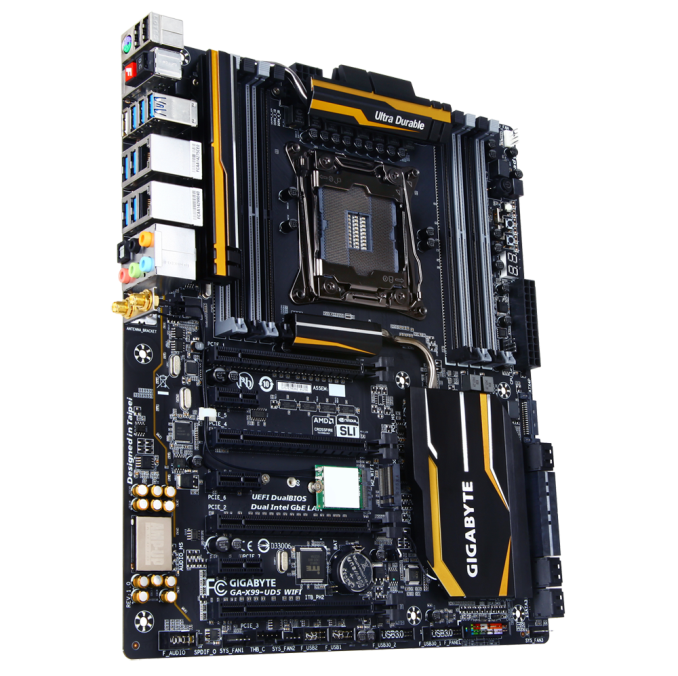Best X99 Motherboards: Holiday 2014
by Ian Cutress on November 27, 2014 8:00 AM EST- Posted in
- Motherboards
- MSI
- Gigabyte
- ASRock
- EVGA
- Asus
- ATX
- X99
- mATX
- Holiday 2014
X99 at $300
When it comes to mid-range X99 motherboards, no single one from the $270-$350 range stands out as being completely awesome or stirring the functionality vs. price balance. There are plenty to choose from all manufacturers, and given that X99 self-builders will most likely already have experience with some motherboard manufacturers, chances are they will stick with the same having had a good experience or choose someone else because of a bad experience. For our guide, while we have not reviewed the following, we’re taking a look at the two motherboards closest to that mark.
ASRock X99 Extreme6 AC, $300
The ASRock X99 Extreme6/AC aims right in the middle of the stack, giving three-way GPU support and the base number of SATA ports. Above the base features, ASRock would seem to have built a motherboard for networking, giving this a dual network port arrangement along with 2T2R 802.11ac WiFi. These go along with ASRock’s Super Alloy branding, giving server class power delivery and XXL heatsinks. Audio is also via ASRock’s Purity Sound 2, an improved ALC1150 regimen.
GIGABYTE X99-UD5 WiFi, $297
The GIGABYTE X99-UD5 WiFi comes across as very similar, offering similar network connectivity via dual network ports and M.2 based 802.11ac WiFi, however the main difference is the four-way GPU support in exchange for ever-so-slightly smaller heatsinks. While GIGABYTE’s BIOS for X99 is still relatively unfocused, their software follows a scrollable application based list allowing for easy updates and additions. The UD5 also comes with a quick overclock button on the rear panel for an easy performance boost.




















15 Comments
View All Comments
2late2die - Thursday, November 27, 2014 - link
I'm surprised the MSI X99S XPOWER (http://www.newegg.com/Product/Product.aspx?Item=N8... isn't on your no-limits list. Spec for spec it offers the same features as the rampage V, even surpassing it in a couple of areas, while maybe lagging behind in couple of others. All that for almost $100 cheaper with better OC tools, and at least in my opinion better aesthetics.Mikemk - Thursday, November 27, 2014 - link
Looking at specs, I hadn't actually realized the x99s was budget.Antronman - Monday, December 8, 2014 - link
The RoG brand name carries a lot of weight.Generation after generation, the leaders in Extreme OCing.
mbaroud - Thursday, November 27, 2014 - link
Does the Asus deluxe support the Samsung xp941?kwerboom - Thursday, November 27, 2014 - link
Will Anandtech a DDR4 Memory Roundup like either http://www.anandtech.com/show/6372/memory-performa... or http://www.anandtech.com/show/7364/memory-scaling-... soon?Senti - Thursday, November 27, 2014 - link
The usual review from Ian – he doesn't even look at what he is reviewing, just copy-pasting the same phrases. "x16/x8/x8/x8/x8/x8/x8 for 7-way compute" on Extreme11 with only 5 PCIe slots? Sure!extide - Sunday, November 30, 2014 - link
Yeah, I noticed that too, pretty sloppy!Also as an aside, I would really like to know the exact PCIe lane allotment for all of these boards. In-fact I would LOVE to see a PCIe lane assignment diagram standard from EVERY motherboard, it would be good to see it in the manual, especially these days as this stuff is getting more and more complex. I would like to AT LEAST see this sort of thing in EVERY mobo review. There is pretty much no excuse for not including that in a review.
domboy - Monday, December 1, 2014 - link
$476-$650? Ouch... that at least used to be the price range for a dual-socket board.Antronman - Monday, December 8, 2014 - link
http://www.newegg.com/Product/Product.aspx?Item=N8...Dual sockets are even cheaper than that, these days.
eanazag - Tuesday, December 9, 2014 - link
X99 board prices are ridiculous.Yes, you can consider dual socket systems. What you can expect in 2P systems: no overclocking (CPU or memory); Intel Xeon CPUs are lower clocked, but have larger caches for more money; very basic audio (no 5.1 or 7.1 possible) or no audio; Xeon CPUs come with no heatsink/fan; may not support SLI and CF, yet have multiple slots; no WiFi; M.2 support might be tough to find; for gaming a $300 Haswell CPU will perform better. You're getting a crazy amount of threads to play with designed to run 24/7, yet thread scaling in most apps won't help you out. You'll need Windows 8.x Pro to use the second socket. 8.x Home only supports 1 socket.
So if you wanted to medicore game and fold at home and GPU mine and run a NAS and encode some movies at the same time, then a 2P system makes sense.